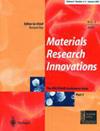Impact of modulated temperature on photovoltaic properties of automated spray fabricated zirconium doped cobalt selenide films
Q2 Engineering
引用次数: 5
Abstract
ABSTRACT The impact of modulated temperature on the synthesizes zirconium doped cobalt selenide material has been investigated in this study. The morphology, structure, elemental composition, behavior in light, and electrical properties of the synthesized materials were investigated using scanner electron microscopy (SEM), X-ray diffractometer (XRD), energy dispersive X-ray spectroscopy (EDX), ultraviolet-visible (UV-vis) spectrophotometer, and a four-point probe device. Due to the agglomeration of the film, the surface morphology exhibits white clove-like clusters and a sizable surface area. The clusters are denser and smaller as the modulated temperature rises, with the exception of the material produced at 205oC, which exhibits large nanoparticles and a small amount of nanotube. The diffraction planes 111, 200, 202, 300, and 311 agree with the spectrum's reported prominent crystalline peak at 2 theta degree angle, which appears at 11.1666, 14.7349, 21.8029, 26.3319, and 30.8953. Bandgaps of 1.39, 1.52, 1.25, and 1.50 eV were found for cobalt selenide-doped zirconium and 1.66 eV for cobalt selenide, respectively. GRAPHICAL ABSTRACT调制温度对自动喷涂制备的掺锆硒化钴薄膜光电性能的影响
本文研究了调制温度对合成的锆掺杂硒化钴材料的影响。采用扫描电子显微镜(SEM)、x射线衍射仪(XRD)、能量色散x射线能谱仪(EDX)、紫外可见分光光度计(UV-vis)和四点探针装置对合成材料的形貌、结构、元素组成、光行为和电学性能进行了研究。由于薄膜的聚集,表面形貌呈现出白色的丁香状簇和相当大的表面积。随着调制温度的升高,团簇的密度越来越小,但在205℃时产生的材料表现出大的纳米颗粒和少量的纳米管。衍射面111、200、202、300和311与光谱报道的2 θ角处的突出结晶峰一致,出现在11.1666、14.7349、21.8029、26.3319和30.8953处。硒化钴掺杂锆的带隙分别为1.39、1.52、1.25和1.50 eV,硒化钴掺杂锆的带隙为1.66 eV。图形抽象
本文章由计算机程序翻译,如有差异,请以英文原文为准。
求助全文
约1分钟内获得全文
求助全文
来源期刊

Materials Research Innovations
工程技术-材料科学:综合
CiteScore
5.20
自引率
0.00%
发文量
38
审稿时长
2.8 months
期刊介绍:
Materials Research Innovations covers all areas of materials research with a particular interest in synthesis, processing, and properties from the nanoscale to the microscale to the bulk. Coverage includes all classes of material – ceramics, metals, and polymers; semiconductors and other functional materials; organic and inorganic materials – alone or in combination as composites. Innovation in composition and processing to impart special properties to bulk materials and coatings, and for innovative applications in technology, represents a strong focus. The journal attempts to balance enduring themes of science and engineering with the innovation provided by such areas of research activity.
 求助内容:
求助内容: 应助结果提醒方式:
应助结果提醒方式:


